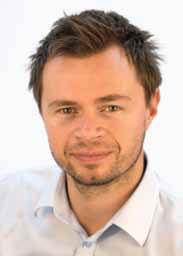The Fast Lane

Anders Løkke Of projectiondesign Lives To Ride With The Quick Pace Of Technological Change
QUICK BIONAME: Anders Løkke
TITLE: International Marketing and Communications Manager
COMPANY: projectiondesign
OVERTIME: Løkke sees the installed AV business sector as one founded on expertise, which perfectly suits the specialty projector products designed and built by Fredrikstad, Norway-based projectiondesign.
SCN: Your university degree is in engineering. What was it initially that drew you to that field?
Anders Løkke: This is quite simple. I’ve always had interest in gadgets, machinery, and fast-moving electronics. I wanted to educate myself within that field, broaden my experience, and work within that. My degree is in electrical engineering so it has been easy for me to apply that to projection technology.
A subject that I enjoyed at university was measurement and analysis of speakers, and I carried out my main study at a nearby internationally renowned speaker manufacturer, SEAS, so my education has been quite broad.
My education was a tremendous help in my work at ASK in the beginning. Also it has been a very valuable asset for my work with projectiondesign as it helps me be more intelligent with what I communicate.
SCN: You began your career as a customer support engineer at Norwegian projector manufacturer ASK. What was the most surprising thing you learned in your first year?
A daily selection of the top stories for AV integrators, resellers and consultants. Sign up below.
AL: Maybe it’s not surprising, but more of a revelation: It goes toward the fact that a confident, skillful, and empathetic support person has so much to do with the relationship with the customer.
It’s vital to have empathy for what the customer experiences in the field, and I didn’t feel this before I started with ASK. This in turn builds relationships with partners, technology suppliers, and other companies. It’s not just fixing a problem, but more understanding it with a user’s point of view.
Our customer base at ASK was a little different then. They were strictly AV and distribution partners, and it was more about box shifting. Now we are targeted and niche so there has been a good learning curve that has lead to our specialist approach to specific projectors.
SCN: While climbing the ranks of product management and marketing at ASK Proxima’s parent company InFocus, how did you see the market influencing product development?
AL: At the time, in the 1990s and early in the year 2000, it was very easy to see, as the projector market was immature and new to people. It was in the days where product sales went to specialist AV reps, dealers, and distributors who then went out and sold products.
Throughout this period, when I was growing up, so to speak, it was easy to see that the model had irreversibly changed. It had become more accessible oriented (i.e., IT distributors selling at a lower price, but with easier access for the buyer).
Also, it was generally understood that presenters all bought their own portable projectors. There was influence in the market for smaller and more portable projectors. This mentality hardly exists now.
The market requirements influence what products come out— and at the time of InFocus, they were smaller and cheaper.

Anders Løkke lever sitt liv som han sykler en sykkel. (Translation: Anders Løkke lives his life like he rides a cycle.) SCN: You joined projectiondesign in 2002, one year after the company was founded. What was your first priority in terms of business development?
AL: We came to market with a specialized product not found anywhere else. We also brought a specialized requirement that puts knowledge back into the distributor and into selling products. In specialized markets there are more margins and more efforts made in the channel.
Our first priority in 2002 was also to go out to market and see the specialists and distributors who had the knowledge and ability to move into their specific markets. These are markets where traditionally AV and IT distribution did not reach. We found our niche here!
My first contribution to all this was in raising the offset of more money in the channel. If the products don’t make money, they won’t go out and sell.
The U.S. traditionally is about 50 percent of our worldwide market. The U.S. in general has a very large degree of installation and uses of product. It doesn’t matter if it’s for specific applications or industries but there is a huge part of the market happening in the U.S. They have special and specific requirements. Many of our large customers originate in America, and we have worked with them and have grown confident that we provide a special service and tool for us to work with.
SCN: What do you feel is the most important issue facing commercial AV integrators today?
AL: How do I stay alive? A great challenge is staying ahead of the game and product curve, enabling one’s competitive edge. It’s not an easy one to play but because of our size, we’re able to be very competitive. Once we’re ahead of the curve, the channels are able to be as well. We also equip them with the right skills and knowledge. Everybody has their specialties.
SCN: How would you complete the following statements?
Design aesthetics can coexist with efficient manufacturing techniques if... product design and development takes all into consideration and integrates it from the beginning.
To build it better, you first have to... clearly understand the user requirement and experience, and pinpoint that down to product shortcomings.
